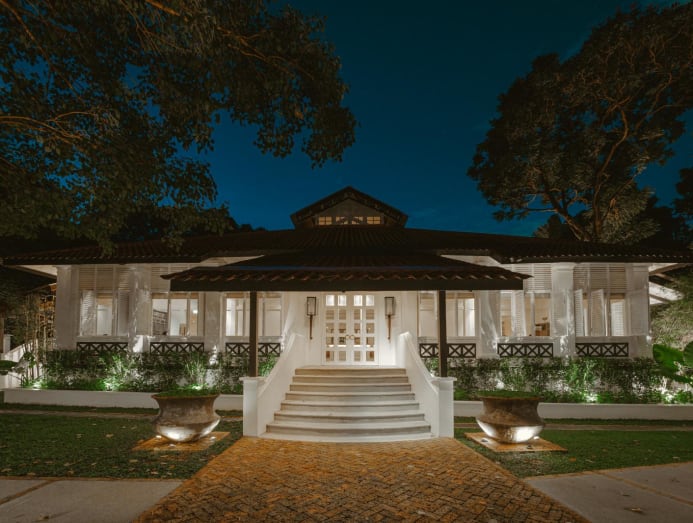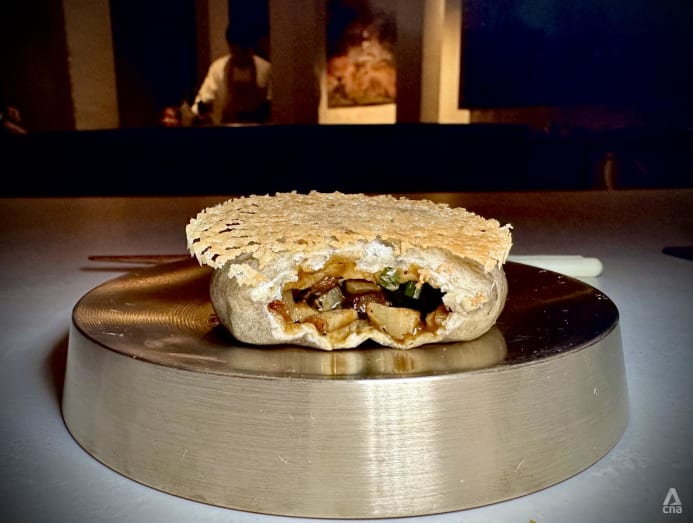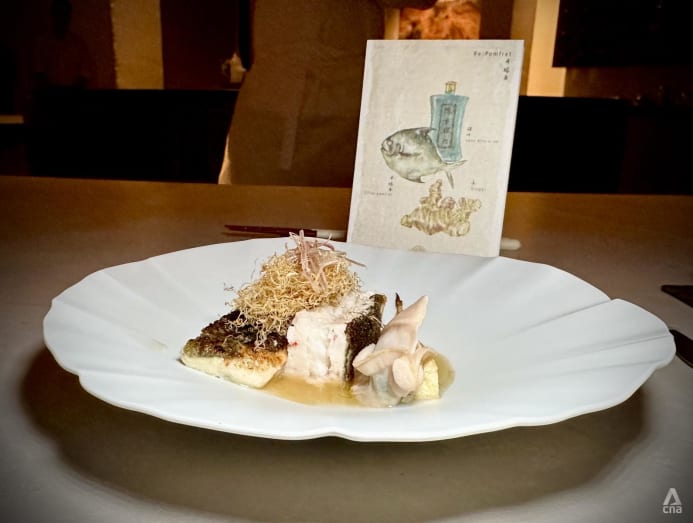Chef Ace Tan opens new restaurant Asu at Labrador Villa with dishes inspired by TCM principles
The striking space at Labrador Villa Road is where the Singaporean chef crafts dishes that explore Asian cultures and histories.

At Asu, chef Ace Tan uses Asian ingredients in his exploration of cuisines. (Photo: Asu)

This audio is generated by an AI tool.
The lush colonial bungalow previously occupied by the Tamarind Hill restaurant has a new and very different lease of life with chef Ace Tan’s newly opened restaurant, Asu.
Tan, well known in the Singapore dining scene after 16 years of cooking and counting, wanted to situate his progressive modern Asian dining concept “close to nature”. “In Singapore, it’s hard to imagine there being a space like this,” he told us.

Located at Labrador Villa Road within Labrador Nature Reserve, Asu, an intimate 28-seater with a small private dining room, shares the building, known as Labrador House, with a bar and a Chinese restaurant, Shan, also overseen by Tan.
Asu serves a tasting menu priced at S$168 (US$128) per person, with add-on options.
Central to Asu’s dining room is a large, organically shaped dining counter wrapping itself around an open kitchen. Rather than having a straight or L-shaped counter, “we wanted to have connectivity as well as the ability to get up close with all the guests”, Tan said, adding that Apple store layouts served loosely as inspiration for the concept.

Meanwhile, Asu’s design is “based on a monastery in nature, almost… a space that has natural elements like wood and stone”, the 43-year-old shared.
That’s because his cuisine, which he’s been developing for the last eight years, is all about diving deep into “the history of Asian cultures” and understanding the origins of what and how we eat, “instead of following what is trendy today or tomorrow”, Tan said.
Many things, especially in Asian cooking, have been “lost through modernisation”, he opined. For example, “It’s an Asian tradition to age braising liquid”. But, in the interest of modern convenience, this is done less and less. “We have been ageing our braising liquid for almost two months now, and it will go on,” he said, adding that Asu also makes their own aged ferments like soya sauce, oyster sauce and fish sauce, as well as syrups and Chinese wine.

On top of that, a thread of Traditional Chinese Medicine (TCM) principles runs through all of Tan’s dishes. Growing up in the Henderson neighbourhood, his aunts and uncles ran a TCM shop at Tanjong Pagar. He spent much of his time there while his parents were at work. TCM “became a very strong influence – ‘You should eat this and that’; ‘This is good for you’. We were never attached to soft drinks or fast food,” Tan recalled.
“I was a bit of a weird kid – I was aligned towards trying to understand food that is helpful to the system.” For example, he’d study all the different kinds of herbal teas sold at the shop. “I was always interested and curious about which drink was for what purpose – curing coughs, improving liver systems, cooling the body.”

But you won’t find overt TCM overtones at Asu. In Asu’s food, he said, his purpose, apart from showcasing flavours and creativity, is to “share why seasonal ingredients are good for your system”. In Asia, “There’s a history of how the influence of the seasons affects what you should be eating. Instead of looking at it medicinally, I’m more interested in the natural benefits of ingredients (and) eating ingredients at their peak… It’s not necessary to ginseng everything.”
In his menus, for instance, Tan shared that he uses ginger, which, according to TCM, promotes digestion, reduces nausea and fights colds. Yam is high in potassium and manganese, which support bone health, metabolism and heart function. Lotus root, when eaten raw, is considered "cooling" and helps to rid the body of excess heat; when cooked, it warms, strengthening the spleen and stomach.
Tan, who pivoted from a career in media planning to following a passion in food sparked by Gordon Ramsay and Marco Pierre White cooking shows, is a chef without formal training. He started out in 2008 at a casual Japanese-French dining concept, moving on to Pollen and Les Amis before opening Ards, his own fine-dining fusion restaurant. He then moved to Korea to work – the name “Asu” is a playful reference to how Korean colleagues pronounced his name – returning to Singapore in 2023 as head chef at a hotel.

The first menu he’s launched, an Autumn menu titled Origins, is a personal one that reflects his growing-up years. For example, a course named “Jessica’s Duck Soup” is an homage to his mother Jessica’s salted vegetable and tomato duck soup. His version, a novel and elevated take on the home-style dish, is served cold with stuffed Amela tomato and preserved mustard greens.

A course of “Shunde Yu Sheng” pays tribute to the raw fish that used to be served with porridge at hawker stalls. Aged kampachi is dressed with a sesame galangal dressing and “house umami essence”, and topped with pine nuts.
“I grew up in the middle of three different food centres – Bukit Merah View, Bukit Merah Central and Redhill Food Centre. I was always in search of good food,” Tan recalled fondly.

An “Oyster Bao”, a tenderly textural parcel of oyster, house oyster sauce, grilled pork collar and Chinese chives, is inspired by another hawker dish, the oyster pancake.

And a “Ngor Hiang” isn’t what you’d expect – it’s a tiger prawn draped in house-made yuba, with five-spiced pork belly and lacto pineapple chilli sauce. “My grandmother did a lot of traditional Hokkien dishes like ngoh hiang… As a kid, I really enjoyed these parcels of things,” Tan said, recalling, at the same time, her Hokkien noodles in gravy: “The black sauce, together with the alkaline taste of the noodles, builds that memory.”
For future menus, Tan hopes to explore more of Asia. “When we grow the team, we would like to have different people from across Asia who can share their culture,” Tan said. “Instead of me going all over the world to work, during which I’d only be able to expose myself to a fragment of the culture, it’s more sensible to accumulate and build a team that comprises different Asian cultures.”
For instance, he currently has a junior sous chef from Myanmar, who “shared about ingredients like laphet or fermented tea leaves. If I didn’t know him, I would never have known about this ingredient.”

While in many restaurants, “because of the nature of (chefs’) experience in the Western fine dining realm, we tend to indulge in many techniques or ingredients previously explored – truffle, caviar, foie gras, or Western vegetables like artichoke. There’s none of that in Asu’s menu,” Tan said. It’s not that non-Asian ingredients have been ruled out, but that there should be a clear purpose for them.
“I think what Asu is really interested in is a stronger progression towards modern Asian cuisine,” Tan said.
Asu is at 30 Labrador Villa Road, Singapore 119189.







